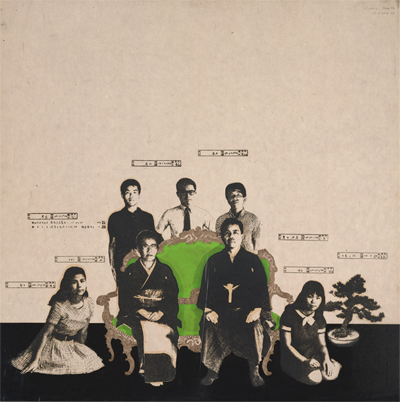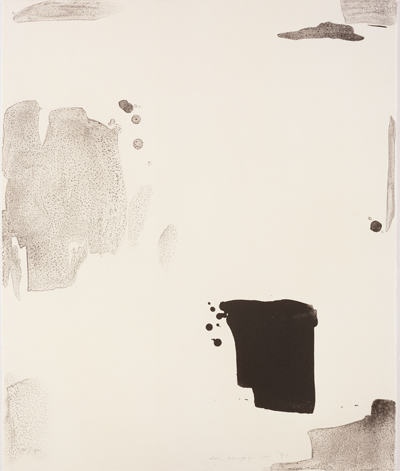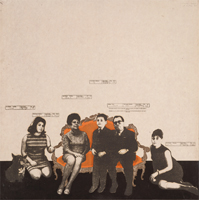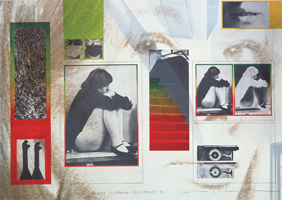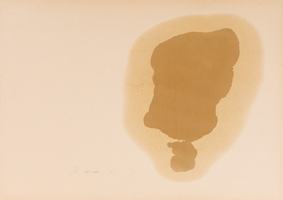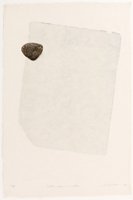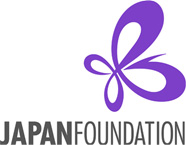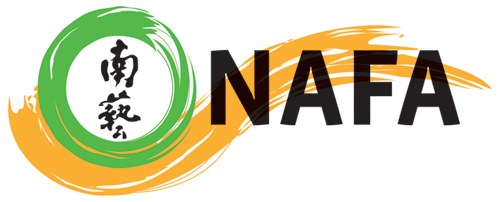Tetsuya Noda (born in 1940)
Born in Kumamoto. Noda began his career in 1968 with Diary, a series which combined woodblock and silkscreen printing, and won the International Grand Prize at the 6th International Biennial Exhibition of Prints in Tokyo later the same year. He subsequently won awards at many other biennales all over the world. The Diary works made consistent use of photographs from everyday life. Noda also worked as a professor at Tokyo University of the Arts.
Kosuke Kimura (born in 1936)
Born in Osaka. After studying Japanese-style painting in university, Kimura began working at an advertising agency. At the end of the ’60s, he began making assemblage-style works with a variety of photographic images from magazines and other sources. In the ’70s, he received numerous awards at biennales both in Japan and abroad, and held solo exhibitions of his work. Kimura also makes sculpture.
Akira Matsumoto (born in 1936)
Born in Osaka. In the ’50s, Matsumoto began working as an ukiyo-e printer, and during this period, he also started to make his own works, which eventually developed into a career as a print artist. In the late ’60s, he produced Pop-like works, depicting pages from the newspaper in prints, and in the ’70s, he converted landscapes and photographs into series of dots. Matsumoto has received countless prizes at biennales in Japan and abroad.
Satoshi Saito (1936-2013)
Born in Tokyo. In the late ’60s, Saito made plastic sculptures, and then in the ’70s, he began producing works using photographs that dealt with the theme of exploring the structure of sight. In 1976, he was awarded the International Grand Prize at the 10th International Biennial Exhibition of Prints in Tokyo. He has also received various prizes at foreign print biennales. Saito’s work frequently appears in exhibitions that examine the use of photography in art and contemporary prints.
Hideki Kimura (born in 1948)
Born in Kyoto. In 1974, Kimura won a prize at the 9th International Biennial Exhibition of Prints in Tokyo for a silkscreen work depicting a photographic image of a hand holding a pencil that was printed on graph paper. He went on to explore the ambiguity between the image of things that are expressed in two dimensions and actual things, producing a wide range of experimental works. In the late ’80s, Kimura formed a group called Maxi Graphica and explored the potential of large-scale prints.
Sakumi Hagiwara (born in 1946)
Born in Tokyo. Hagiwara began his career in the ’60s as an actor in underground theatre, and later worked as a stage director and a filmmaker. In the ’70s, he began making silkscreen prints, was awarded a prize at the 10th International Biennial Exhibition of Prints in Tokyo in 1976, and showed his works in international print biennales abroad. Hagiwara’s works from this period are often included in exhibitions that focus on trends in contemporary prints.
Jiro Takamatsu (1936-1998)
Born in Tokyo. In the ’50s and early ’60s, Takamatsu created various avant-garde works, including Happenings and performances. In the late ’60s, he began producing work that questioned our visual perception of the outside world, which exerted a strong influence on the Mono-ha movement. Takamatsu also made prints in the late ’60s, and in the early ’70s received attention for works that questioned the print concept.
Katsuro Yoshida (1943-1999)
Born in Saitama. In the late ’60s, Yoshida became active as a Mono-ha artist, showing work in which he combined various kinds of matter. In 1970, he used silkscreening to depict photographic images, and subsequently took an active interest in printmaking while also making paintings. Yoshida’s work is frequently shown in exhibitions that reexamine contemporary art trends of the late ’60s and ’70s.
Koji Enokura (1942-1995)
Born in Tokyo. In the late ’60s, Enokura began showing works made up of places and situations in which a sense of tension was created by a physical (body) response to matter. These works were intended to affirm the existence of the self. He won a prize at the Paris Youth Biennale in 1971. Enokura began making prints in the ’70s and was awarded a prize at the 11th International Biennial Exhibition of Prints in Tokyo in 1979.
Shoichi Ida (1941-2006)
Born in Kyoto. After a period in which he made Pop-like prints, Ida developed the concept of “surface is the between” in the mid-’70s, focusing primarily on prints but also working in a variety of other formats including oil painting, paper, ceramics, and bronze. Ida won a prize at the 10th International Biennial Exhibition of Prints in Tokyo in 1976 and other awards at various foreign biennales.
Tatsuo Kawaguchi (born in 1940)
Born in Kobe. Based on the notion that matter and people were equal, in the ’60s, Kawaguchi began creating work that dealt with the relationship between matter and people, and between various kinds of matter. In the ’70s, he imprinted rust from fragments of iron and copper on fabric and made paper that incorporated rusty nails and clamps to expand the concept of prints. He was awarded a prize at the 11th International Biennial Exhibition of Prints in Tokyo in 1979.
Lee Ufan (born in 1936)
Born in Gyeongsangnam-do, Korea. In 1956, after leaving the College of Fine Arts at Seoul National University, Lee came to Japan and began studying philosophy at Nihon University. At the beginning of the ’60s, he began making art and by the end of the decade, he was creating works with matter as a subject in which he combined various materials. During this period, he also published essays and criticism, and developed theories that would in time come to be referred to as Mono-ha. Lee has been making prints since the ’70s.
Mitsuo Kano (born in 1933)
Born in Tokyo. While devoting himself to the poetry of Rimbaud and others, Kano began making copperplate prints in 1953. He attained prominence in the art world after holding a solo exhibition that was championed by the poet and art critic Shuzo Takiguchi. He won a prize at the 3rd International Biennial Exhibition of Prints in Tokyo in 1962 as well as other awards in various Japanese and foreign exhibitions. In addition to making intaglio prints and lithographs, Kano has produced countless oil paintings.
Arinori Ichihara (1910-2010)
Born in Tokushima, but spent his childhood in Hokkaido. In the late ’20s, Ichihara wrote haiku while working at the Ministry of Posts and Telecommunications. In the late ’50s, he began making monotype prints and focusing on printmaking. Gradually, he began creating prints using the uneven texture of various metal sheets that were corroded by different types of chemicals. Ichihara also produced many large-format monotype prints.
|




